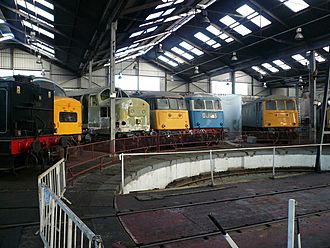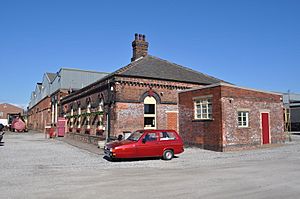Barrow Hill Roundhouse facts for kids
Quick facts for kids Barrow Hill Roundhouse |
|
|---|---|

A mix of steam, diesel and electric locomotives facing the roundhouse turntable
|
|
| Alternative names | Staveley Roundhouse |
| General information | |
| Status | Listed Building, Museum |
| Type | Roundhouse |
| Town or city | Barrow Hill, Derbyshire |
| Country | England |
| Coordinates | 53°16′28.00″N 1°22′54.50″W / 53.2744444°N 1.3818056°W |
| Current tenants | Barrow Hill Engine Shed Society |
| Opened | 1870 |
| Renovated | 1998 |
| Cost | £16,445 4s 9d |
| Client | Midland Railway |
| Owner | Chesterfield Borough Council |
| Design and construction | |
| Main contractor | I.E. Hall |
|
Listed Building – Grade II
|
|
| Official name: Engine Shed 200 metres west of Campbell Drive (in unnamed road) | |
| Designated: | 5 February 1991 |
| Reference #: | 1140134 |
Barrow Hill Roundhouse is a special place in Barrow Hill, Derbyshire, England. It used to be a big building where trains were kept and repaired. It was built by the Midland Railway company. Today, it's a museum and a heritage center for old trains. It's like a home for many historic locomotives!
Contents
History of the Roundhouse
The Barrow Hill Roundhouse was built a long time ago in 1870. It was first known as Staveley Engine Shed. It had a special design with a central turntable inside. A turntable is a rotating platform that helps turn locomotives around.
The building was used for trains until 1991. After 1948, its name changed to Barrow Hill. This was to avoid confusion with another train shed nearby.
Saving the Roundhouse
After it closed in 1991, the building was damaged by vandals. People in the local area worked hard to save it. In February 1991, the building was given a special protection status. This meant it was a "Grade II listed" building. This protects important historic places.
The Chesterfield Borough Council became the new owner of the shed in 1996. They then worked with the Barrow Hill Engine Shed Society. This group helped fix up the site. They even replaced the original glass roof from 1870.
Many groups helped pay for the repairs. These included the local council, the Transport Trust, and the European Regional Development Fund. The site officially reopened to visitors in July 1998.
Today, the Roundhouse is still connected to the main UK train lines. It is home to many old British trains that have been saved. A company called Harry Needle Railroad Company also keeps and fixes trains there. Barrow Hill also has an old Signal box from Pinxton. It was moved there and restored to look like it did when it was last used.
Amazing Locomotives at Barrow Hill
Barrow Hill Roundhouse is home to many cool locomotives. Some are on display, some are being fixed, and some can even run! Here are some of the preserved trains you might see:
Steam Locomotives
- GER Class G58 (LNER Class J17) 0-6-0 no. 8217: Built in 1905. It's on loan from the National Railway Museum and is on display.
- GCR Class 11F (LNER Class D11) 4-4-0 no. 506 Butler Henderson: Built in 1919. Also from the National Railway Museum, on display.
- MR 156 Class 2-4-0 no. 158A: Built in 1866. On loan from the National Railway Museum, on display.
- MR 1000 Compound Class 4-4-0 no. 1000: Built in 1902. From the National Railway Museum, on display.
- MR 1F "Half-cab" 1377 Class 0-6-0T No 41708: Built in 1878. It is currently being repaired.
- BR Standard Class 4 2-6-4T no. 80079: Built in 1954. On loan from the Severn Valley Railway, on display.
- Hunslet Engine Company "Austerity" 0-6-0ST Works no. 3192, Running no. 68006: Built in 1955. It is currently being repaired.
- Hawthorn Leslie 0-4-0ST no. 2491 Henry: Built in 1901. On display.
- Vulcan Foundry 0-4-0ST no. 3272 Vulcan: Built in 1918. This one can run!
Diesel Locomotives
- Drewry Car Co. 0-4-0 no. 2589 Harry: Built in 1956. This one can run!
- BR 0-4-0DH Class 02 no. 02 003 (D2853): Built in 1960. It can run.
- BR 0-4-0DH Class 02 no. D2868: Built in 1960. It can run.
- BR 0-6-0DM Class 03 no. 03 066 (D2066): Built in 1959. It can run.
- BR 0-6-0DE Class 07 no. 07 012 (D2996): Built in 1962. On display.
- BR 0-6-0DHClass 10 no. D4092: Built in 1962. On display.
- BR Bo-Bo Class 23 "Baby Deltic" no. D5910: This is a new version of an old train, made in 2010.
- BR Bo-Bo Class 26 no. 26 007 (D5300): Built in 1958. It can run.
- BR Bo-Bo Class 27 no. 27 066 (D5386/27 103): Built in 1962. It is stored here.
- BR 1Co-Co1 Class 45 no. 45 060 (D100) Sherwood Forester: Built in 1961. It can run.
- BR 1Co-Co1 Class 45 no. 45 105 (D86): Built in 1961. It is being restored.
- BR Co-Co Class 55 no. D9009 (55 009) Alycidon: Built in 1961. It can run.
- BR Co-Co Class 55 no. D9015 (55 015) Tulyar: Built in 1961. It is being repaired.
- BR Co-Co Class 55 no. 55 019 (D9019) Royal Highland Fusilier: Built in 1961. It can run.
Electric Locomotives
- BR Bo-Bo Class 81 no. 81 002: Built in 1960.
- BR Bo-Bo Class 82 no. 82 008: Built in 1961.
- BR Bo-Bo Class 83 no. E3035 (83 012): Built in 1961.
- BR Bo-Bo Class 85 no. 85 006: Built in 1961.
- BR Co-Co Class 89 no. 89 001: Built in 1986.
See also
- Listed buildings in Staveley, Derbyshire


